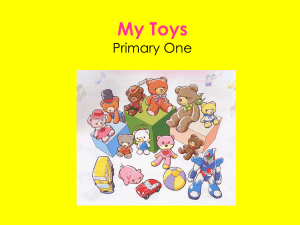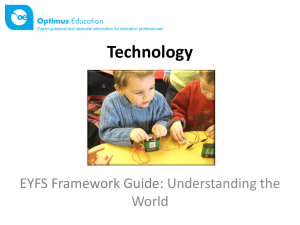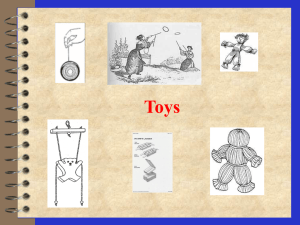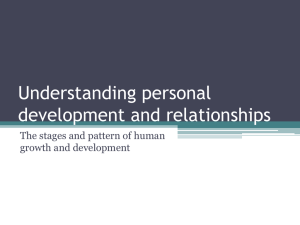Children For Children
advertisement
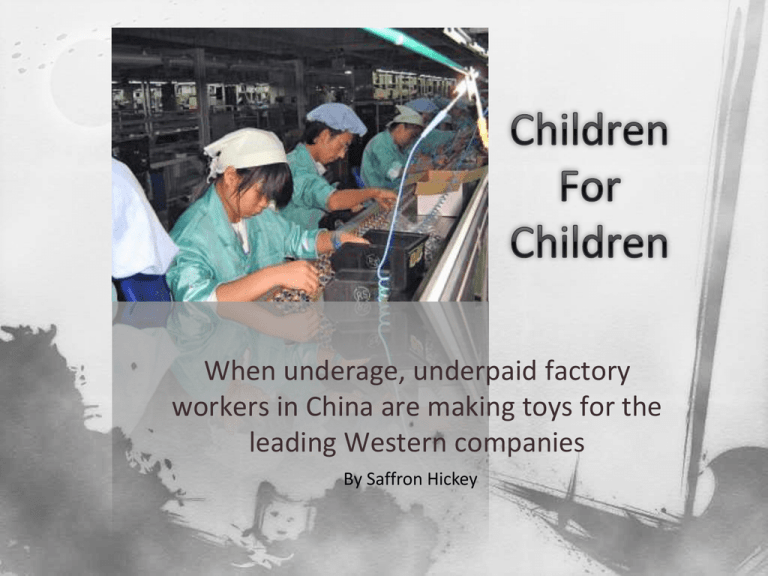
When underage, underpaid factory workers in China are making toys for the leading Western companies By Saffron Hickey To define and accomplish the changes that must be made to protect the essential human and workers’ rights of young people working in toy factories in China. Children for Children will seek to educate consumers on the problems, influence leading Western corporations to take action, and demonstrate the differences that will combat this age-old issue. We will replace reckless outsourcing with international collaboration to use the root cause of globalization to our advantage. “Made in China” label on a stuffed animal toy. Dated 2007. Focus question: How did this become a symbol of toy manufacturing and globalization? A look at the history of toys, manufacturing, materials, factories, and the Chinese economy. Since the beginning of time, children have had play materials. Children are usually able to make games with whatever they have around, but even in the ancient times toys were popular. Egyptian children played with dolls that had wigs and movable limbs. Little horse on wheels Ancient Greek and Ancient Roman (Ancient Greek child's toy). children played with bows-andFrom tomb dating 950-900BC. arrows and yo-yos. Back then, toys were usually made by family members or the children themselves. Portrait of a girl with a doll in Denver, Colorado. Dating from between 1904 and 1915. By the 20th century, dolls had been made to talk. Times were changing; toys had been produced by stores for centuries, though they were usually only affordable for the upper class. By the 1950s, it was almost unheard of to make toys at home, especially as the quantity of cheap toys available increased. The Rubik’s Cube, popularized in the 1980s, was made possible by the invention of easy-to-shape materials such as plastic. The 1980s brought a change in the Chinese economy; the migration of populations from rural to urban areas brought a new kind of capitalist market economy. The world was a global field and exporting goods was a simple way to accumulate capital. With plastic and people readily available, and with the children of the world ready for more and more low-quality toys, the “Made in China” staple was born. Two toy factory workers in Guangdong province, China. Dated 2003. Focus question: What do these girls know about the children who buy the products they make? How toys are made, from the factory floor to the store shelf. Factories use local workers who are more willing to accept poorer working conditions and lower wages (due to cultural, political and governmental influences). Young workers may need to earn money to support themselves or their families. Toys are made in Chinese factories with poor working conditions, low wages, underage workers, health and safety concerns, aggressive management, and tense atmospheres. China produces 75% of the world’s toys, exporting them to Europe, America, Australasia and other places around the world. Transnational companies import products without question. Parents and children all over the world buy Disney, Mattel, Fisher Price, Walmart, and other brand name toy products. Activist individuals, groups and organizations, like SACOM, try to inform consumers of the human rights concerns of toy manufacturing, along with trying to influence transnational corporations to change. Room full of second-hand toys. Dated 2003. Focus question: Why is this business succeeding? The ongoing effects of supplying brand-name, low-cost toys. Chinese workers Western consumers Get used to the excessive overtime and dangerous working conditions. Understand that it is extremely difficult to find work, and feel they must “make do”. Are anxious about reporting their concerns in case they get fired. Develop negative perspectives on western consumers. Parents must send their children (as young as 14) to work because they cannot afford to look after the family all by themselves. Get used to buying toys from recognized companies. Are happy that they are getting a “good deal” on low toy prices. Presume transnational corporations are constantly checking the working conditions of their suppliers. Teach their children about ethics and human rights whilst not understanding it themselves. If they are suspicious, they lose interest because it is hard to find concrete, accurate information. Chinese factories Western corporations Are anxious to meet the demand of the Western market. Want to stay in the “good books” of corporations to keep in work. Struggle to balance cheap products in high quantities with workers’ rights. Try to hide any sacrifices they feel they have to make (wages below legal minimum, excessive overtime, dangerous working conditions) in case they are close down. Intimidate workers to maximize product and minimize complaints. Become trusting of their suppliers. Do not want to highlight too many concerns in countries where they are not certain of what is acceptable. Find it hard to accumulate accurate information in investigations. Rely on other organizations, like the International Council of Toys Industries, to keep the factories in check. Try to assure customers of their clean products. Are, after all, a business that relies on profit. Young female workers sew clothes for Barbie dolls. Dated 2010. Focus question: How can we make things fair for them? Changes that need to be made and how you can help. Stop basing the evaluation of working conditions on culturally and socially acceptable standards; follow legal regulations of all countries involved. Pay more for products that are guaranteed to have been manufactured safely and ethically. Have set regulations that allow for young workers but make sure their rights are accurately outlined. Offer more help to workers, including unions to which they can report their concerns and organizations to help them find new jobs if they need to. Although the changes needed must be made by all parties of the toy manufacturing process, the party that the rest all depend on is consumers. If consumers can adapt the way they shop for toys and products, the corporations and factories will have to change too. What you can do: Think about how many toys a child really needs. Ask for their input on choosing toys. Buy good-quality toys that will last them. Try simple toys without brand-names or special characters. Check out second-hand shops for toys. Recycle or reuse old and broken toys. Write or phone corporations and organizations for concrete information on the suppliers of their products. Follow these links for more information: Stop China’s Unsafe ‘Sturdy Products’ Child Labor Factory. A petition you can sign online with Force Change; it targets major toy retailers and suppliers, and aims to end child labor and harsh Chinese factory conditions. Disney factory faces probe into sweatshop suicide claims: Human rights campaigners say Chinese factories using children as young as 14 and that workers forced to do overtime. An article by Gethin Chamberlain of the Guardian. International Council of Toy Industries: promoting international toy safety standards and a responsible attitude to advertising and marketing to children. Find information at their website, including their CARE (Caring, Awareness, Responsible, Ethical) Process for ethical toy manufacturing. SACOM, Students and Scholars Against Corporate Misbehaviour, critiqued the above certification system after a toy factory worker committed suicide. Mattel wrote a letter in response to the allegations of the report. Other publications of interest by SACOM. Reports on Disney’s Chinese suppliers: 1, 2. Labour Rights and ICTI: 1, 2. Walmart’s unsuccessful monitoring of sweatshops. London 2012 Olympics mascot toys. Also, find more at their website. Tung, Allison. (2011). Stop China’s Unsafe ‘Sturdy Products’ Child Labor Factory. Retrieved March 13, 2012, from http://forcechange.com/3737/stop-chinas-unsafe-sturdy-products-child-labor-factory/ Korn, Stefan. (2007). More Chinese Whispers – Baby Brands Manufacturing in China. Retrieved March 13, 2012, from http://www.diyfather.com/content/baby-brands-manufacturing-in-china Mollerus, Sharon. (2009). Little Horse on Wheels (Child’s Toy). Retrieved March 13, 2012, from http://en.wikipedia.org/wiki/File:Little_horse_on_wheels_(Ancient_greek_child%27s_Toy).jpg Lillybridge, Charles. (Early 1900s). Portrait of a girl with a doll in Denver, Colorado. Retrieved March 13, 2012, from http://en.wikipedia.org/wiki/File:Child_and_Doll.jpg Gonzalez, Mike. (2005). Rubik’s Cube in scrambled state. Retrieved March 13, 2012, from http://en.wikipedia.org/wiki/File:Rubiks_cube_scrambled.jpg Wolf, Michael. (2003/4). The Real Toy Story. (Multiple images) retrieved March 13, 2012, from http://www.photomichaelwolf.com/the_real_toy_story/ Green, Derek. (2011). New Sweatshop Scandals for Disney, Mattel and Apple. Retrieved March 13, 2012, from http://articles.businessinsider.com/2011-08-29/news/30018487_1_child-workers-factory-toxic-chemicals Marqueed. (2009). Containers and cranes. Retrieved March 13, 2012, from http://en.wikipedia.org/wiki/File:YangshanPort-Containers.jpg Budget shopping for your kids. (n.d.). Retrieved March 13, 2012, from http://www.sheknows.com/shopping/articles/5950/budget-shopping-for-kids-save-money-when-buying-clothes-for-kids Jollykorova. (2009). Still Looking for Mickey Mouse's Conscience: SACOM's Struggle for the Rights of Workers at Disney Suppliers Continues. Retrieved March 13, 2012, from http://www.globalcorpforum.org/en/node/72 Outsourcing China Advantages. (2010). Retrieved March 13, 2012, from http://www.china-sourcingagent.com/2010/07/outsourcing-china-advantages/




